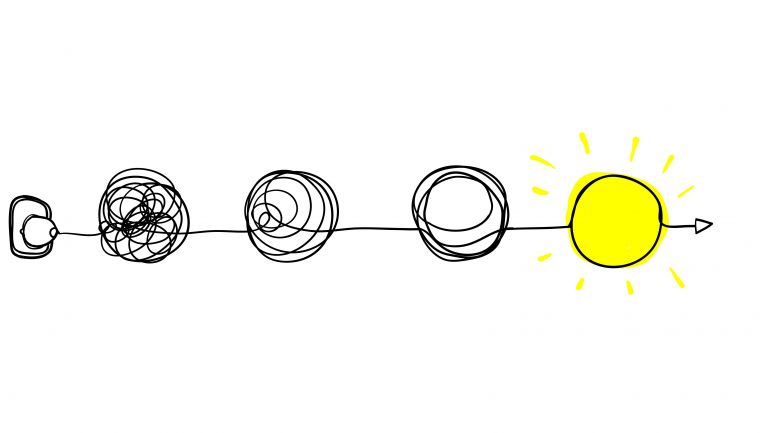Sign up for our monthly newsletter

The six books that are shaping our design thinking right now...
As leaders in design thinking, at ThinkPlace we are always interested in challenging ourselves with a disruptive idea; a new way of seeing the world and all its complexity.
Part of that curiosity and openness is a passion for books. Our ThinkPlace library is constantly restocked and we delight in sharing our favourite readings with each other. Now we're sharing them with you. We asked six of our top thinkers and global leaders to describe the book that is currently shaping their thinking as designers and change agents...

Darren Menachemson
Partner ThinkPlace Australia, Head of Digital
Right now I am reading?
Leonardo Da Vinci: The Biography. By Walter Isaacson

With Isaacson's usual attention to detail, he brings together Da Vinci's many dimensions - artist, engineer, anatomist, outsider, truth-seeker, procrastinator - into a single portrait of a unique thinker who barely escaped the life of a Florentine notary.
What I like about it...
Leonardo left thousands of pages of notebooks as his legacy, but they gave fewer clues than one would imagine about Da Vinci as a person. Triangulating these with a receipt here, a contract there, this letter and that written observation, he wrestles Da Vinci's psyche and story out of the dimness of history. We get to see perhaps the world's greatest designer clearly, in a way where we can learn from the best and worst lessons he had to offer.
How it relates to the challenges we face in the world.
Leonardo was relentlessly, obsessively curious. Whether he was dissecting cadavers to understand the interaction between musculature and nerves, or watching the motion of a bird as it flew off the branch, he was never satisfied with received wisdom. Instead, he would go out into the world to answer questions others hadn't even thought to ask, and gather evidence. This curiosity elevated his art and conceptual thinking well beyond that of his peers.
How it relates to the work we do at ThinkPlace?
If we ever needed to appreciate the irreplaceable role of ethnography in the practice of designing sociotechnical and socioeconomic systems, Isaacson's book gives us a powerful case study to advocate for it.

Leslie Tergas
Partner, ThinkPlace NZ
Right now I am (re)reading…
The Opposable Mind; Winning through Integrative Thinking. By Roger Martin

This book describes integrative thinking—the ability to hold two opposing ideas or requirements in one’s mind at once, and to resolve the tension through an innovative third way. There are examples of it at play as well as a description of the process that sits behind this way of being. More importantly, by describing this way of thinking, it means that is it a way of approaching problems and the world that can be cultivated—we can grow our opposable minds, and we can grow our capacity for integrative thinking.
What I like about it...
Integrative thinking is design thinking. What I like about the book is that it describes our way of thinking without using the word design. I have recently assigned it to our Humming Business Team to understand what a designerly mindset is all about and how it can be applied in all aspects of our business, not just client work.
How it relates to the challenges we face in the world.
Solving complex and urgent challenges in the world requires the ability to see the current state as models of reality that we have constructed, therefore models of reality that we can re-design. I call this the innovation stance—having the courage to see what is, but even more, having the courage to see that can be. This is not the work of a few gifted geniuses—it is the work of all of us.
How it relates to the work we do at ThinkPlace?
I like to give this book to clients and to people who say “I’m not a designer.” People can have a very narrow definition of what being a designer is. I say we are all designers who are thinking of a better way to get us to a preferred future. And that is the thinking process that this book describes. The key is to reject the idea of a trade-off—that is a reductive and pessimistic mindset. Holding opposing ideas and then synthesising the best of both into a third way is what design is about—and it is the ThinkPlace way. This book changes a narrow view of what design thinking is, into an understanding that sparks participation. It’s the Best book I’ve ever read for demystifying the essence of design thinking.

David Ireland
Chief Innovation Officer
Right now I am reading...
The Inevitable, by Kevin Kelly.

This book is about understanding the 12 technological forces that will shape our future. I like it as it is taking a different approach to thinking about trends, as the book is focusing on the forces that are pushing us in certain directions.
In this way, the forces are less 'destiny' focused like megatrends are, and more 'trajectory' focused. We need to know this type of thing if we are to design solutions that are going to withstand the shifting sands of time.


Bill Bannear
General Manager, ThinkPlace Singapore
Right now I am reading…
The Patterning Instinct. By Jeremy Lent

This book explores how humanity's way of perceiving the world has evolved over time, and the importance of metaphor to construct cultural meaning. The metaphors shape the norms of our societies, and differ across people. The patterning instinct refers to the brain's amazing ability to take all our sensory data, and interpret it, and make sense of it.
What I like about it...
I like it because it is an inquiry into the subconscious factors that influence the way we each experience the world. It opens up opportunities for resonant storytelling and deeper mutual understanding. It's closely linked to language and symbols.
How it relates to the challenges we face in the world.
Most of the problems we deal with span different groups of people with different worldviews. Sometimes it's these worldviews, and the behaviours that relate to them, that contribute to the problems. Meaningful dialogue is at the root of good codesign, and we need to be conscious of the barriers.
How it relates to the work we do at ThinkPlace?
Just as culture shapes us, we also shape the culture around us. At ThinkPlace, we're often designing with people from all cultures and walks of life. We need to be able to surface our metaphors, norms and worldviews to create cross-cultural designs. And then we get to the really interesting bit: the opportunity to create new technologies of the mind together, that actively influence the culture around us going forwards.

Nina Terrey
Partner, ThinkPlace Australia. Chief Methodologist, ThinkPlace Global.
Right now I am reading?
A higher loyalty. By James Comey

What I like about it...
This book is written by the ex-FBI Director who reflects on his career. His honesty about himself, his values and choices he has made in his career are built around the idea of always trying to do good in light of the law, politics and society.
How it relates to the challenges we face in the world.
The challenges to operate toward shared outcomes and good are not a simple or easy path. The degree in which we can see justice, peace and positive outcomes is a constant process of dialogue, framing, reframing and negotiating but doing these things in a way that does not compromise core values.
How it relates to the work we do at ThinkPlace?
We work in the middle of complexity, and alongside clients who have specific goals to engage and bring in others. This opens us to the same tensions that Comey talks about – what are our core values that we bring to every job – agency, ethics, outcomes – and not to compromise on these, along with shifting mindsets towards the greater good – even if people do not want to hear this. We create contexts that allow productive change to occur and often this feels hard – but we do it because we care and are passionate about the results.

John Body
Founding Partner, ThinkPlace Australia
Right now I am reading..
Factfulness. By Hans Rosling

What I like about it…
In 1966 half of the world’s population lived in extreme poverty, that is less than US$2 per day. Today that figure is 9 percent. Around 90% of girls across the world finish primary education. For boys it is 92%. Violent crime in most countries is in steady decline. Across a broad number of indicators bad things are decreasing and good things are increasing.
Yet our perception is the opposite. Across the world people perceive things are getting worse. When asked fact based multiple choice questions, respondents regardless of background, consistently score worse than if had they answered randomly.
How it relates to the challenges we face in the world.
Each year in time for the northern summer, Bill Gates recommends about five books for holiday reading. This year he recommended a book which in his words is “one of the most important books I’ve ever read – an indispensable guide to thinking clearly about the world”. Equally, Melinda Gates says that the book “explains why progress is so often secret and silent and teaches readers how to see it clearly”.
How it relates to the work we do at ThinkPlace?
With the ThinkPlace audacious goal to shift the needle on the Sustainable Development Goals, constant bad news can make us think of the futility of the task. Yet despite what we hear, the world is progressively improving.
Rosling outlines 10 factfulness rules of thumb.
1. Gap – we often divide the world into the developed countries vs the developing. The data shows this is a fallacy – there is no gap. Countries are distributed evening along income levels and all are improving.
2. Negativity – the majority of social and economic indicators are steadily improving over time. Yet the majority of people think they are worsening. This is because we hear the negative stories but there is no news in gradual improvements.
3. Straight line – we assume trends will continue for ever yet they rarely do. This makes many of our forecasts based on a linear projection wrong.
4. Fear – humans are very poor at assessing risk. Major risks like car accidents we dismiss but insignificant risks like shark attacks we exaggerate.
5. Size – Always look at numbers with some form of comparison or ratio. A number on its own can be misleading without seeing its context.
6. Generalisation – Question categories. Look for difference in categories. Look for similarities across categories.
7. Destiny – We can often miss slow but steady change. It is not newsworthy but over the long term we can be making false assumptions.
8. Single – Numbers on their own are necessary but insufficient to understand complexity. We need multiple research tools in our toolbox.
9. Blame – With many issues we look for a single person to blame. In a complex system most of the people have a small part to play in the results of that system.
10. Urgency – Issues are often portrayed as urgent but they rarely are. We have time to chart better courses of action.
Read this book to make better sense of the complexity that we work with.
Want to know more about our ideas and work? Join CIPI: Our new community for global changemakers.







